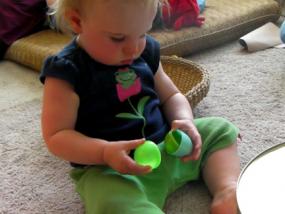Infants Come with Questions

We catch Evelyn at 12 months, eager to know, exploring the hollow halves of plastic eggs, lifting and banging a large tin can. But more than pedestrian descriptions of one child’s play, this video bears witness to the way our species approaches objects with our own questions. Is this object a whole or does it have parts that separate? Can these separate objects be stuck together or do they fall apart? If I put them together can they be taken apart? These questions about the continuity of objects – where they begin, where they end, how they come apart, how they fit together – come to our species naturally, without teaching, and have to be answered in order for any child to deal with the thousands of small problems he encounters each day. Is this a lid on a jar or a raised lip on the rim? Can I grab a shadow? Is this long thing part of the dog (tail) or separate (leash)? Are these the head and tail of the same worm or the head of one worm and the tail of another? Have I broken this toy or dislodged a joint?
Watch this video with a more universal frame of mind, one in which Evelyn represents our species. Think about what her actions tell us about her questions. Here are a few examples:
1. Can I join these two objects so that they do not come apart?
2. Is this object interfering with my goal to join these other two objects?
3. Is this object incomplete (e.g. half of a whole)?
4. Will this object be more stable if I put its open side on the drum?
5. Is this large object (tin drum) attached to the floor?
6. Will these small objects slide if I tilt the tin drum?
Notice that Evelyn does not try to “make an egg” by joining two halves open end to open end. She inserts the dome of one into the hollow of the other. Does this strategy make it more reasonable that she is asking question #1 but not #3? Enjoy her curiosity and the steady flow of her research.
Runtime 6 minutes 18 seconds
